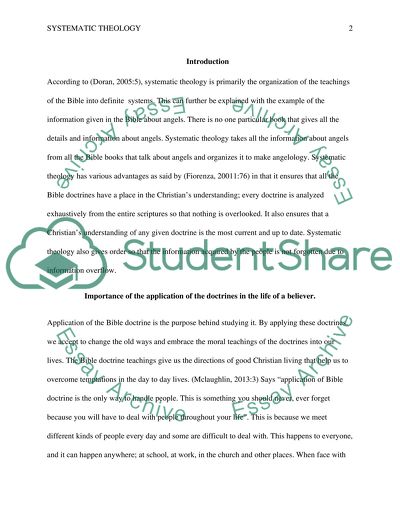Are you ready to discover 'systematic theology essay'? Here you can find your answers.
Aweigh Essays Systematic divinity is defined every bit the attempt to create or to formulate a consistent philosophy that tooshie be applied to the necessary aspects and parts of a certain faith’s system of beliefs and ideologies. Accordant to Walter Elwell, systematic theology is the definitive affirmation of dispensational divinity.
Table of contents
- Systematic theology essay in 2021
- Systematic theology topics
- Systematic theology for beginners
- Systematic theology doctrines
- How to write a systematic theology paper
- Systematic theology meaning
- Systematic theology summary
- Systematic theology examples
Systematic theology essay in 2021
 This image representes systematic theology essay.
This image representes systematic theology essay.
Systematic theology topics
 This picture shows Systematic theology topics.
This picture shows Systematic theology topics.
Systematic theology for beginners
 This image representes Systematic theology for beginners.
This image representes Systematic theology for beginners.
Systematic theology doctrines
 This image representes Systematic theology doctrines.
This image representes Systematic theology doctrines.
How to write a systematic theology paper
 This image illustrates How to write a systematic theology paper.
This image illustrates How to write a systematic theology paper.
Systematic theology meaning
 This picture demonstrates Systematic theology meaning.
This picture demonstrates Systematic theology meaning.
Systematic theology summary
 This picture representes Systematic theology summary.
This picture representes Systematic theology summary.
Systematic theology examples
 This picture representes Systematic theology examples.
This picture representes Systematic theology examples.
When did systematic theology become less popular than confessionalism?
Systematic theologies became less popular in the eighteenth century, as confessionalism declined and Enlightenment skepticism made headway, but there was a certain revival after 1800.
Which is the best description of Systematic Theology?
Systematic theology is the attempt to organize all Christian doctrines in a logical order. The Christian church has been practicing this type of theology since the very early stages of the Church, although the form in which we see it today developed in the middle ages.
Who was the founder of the scholastic method of Theology?
Scholastic theology, as this method is known, quickly developed into a science of its own. Its most famous exponent was Thomas Aquinas (1226–1274), whose Summa contra Gentiles ( Summary against the Gentiles) and later his massive Summa Theologiae ( Summary of Theology) are its greatest monuments.
Where does the systematic approach to Christianity come from?
A systematic approach to Christian doctrine first appears in the second-century baptismal confessions that later formed the basis for the Apostles’ and Nicene Creeds. In these statements of faith, we find a Trinitarian pattern—God the Father is put first, followed by God the Son, and finally by God the Holy Spirit.
Last Update: Oct 2021